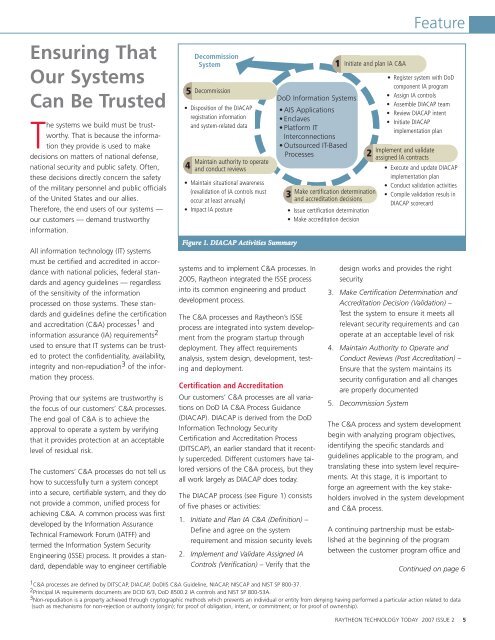2007 Issue 2 - Raytheon
2007 Issue 2 - Raytheon
2007 Issue 2 - Raytheon
You also want an ePaper? Increase the reach of your titles
YUMPU automatically turns print PDFs into web optimized ePapers that Google loves.
Ensuring That<br />
Our Systems<br />
Can Be Trusted<br />
The systems we build must be trustworthy.<br />
That is because the information<br />
they provide is used to make<br />
decisions on matters of national defense,<br />
national security and public safety. Often,<br />
these decisions directly concern the safety<br />
of the military personnel and public officials<br />
of the United States and our allies.<br />
Therefore, the end users of our systems —<br />
our customers — demand trustworthy<br />
information.<br />
All information technology (IT) systems<br />
must be certified and accredited in accordance<br />
with national policies, federal standards<br />
and agency guidelines — regardless<br />
of the sensitivity of the information<br />
processed on those systems. These standards<br />
and guidelines define the certification<br />
and accreditation (C&A) processes 1 and<br />
information assurance (IA) requirements 2<br />
used to ensure that IT systems can be trusted<br />
to protect the confidentiality, availability,<br />
integrity and non-repudiation 3 of the information<br />
they process.<br />
Proving that our systems are trustworthy is<br />
the focus of our customers’ C&A processes.<br />
The end goal of C&A is to achieve the<br />
approval to operate a system by verifying<br />
that it provides protection at an acceptable<br />
level of residual risk.<br />
The customers’ C&A processes do not tell us<br />
how to successfully turn a system concept<br />
into a secure, certifiable system, and they do<br />
not provide a common, unified process for<br />
achieving C&A. A common process was first<br />
developed by the Information Assurance<br />
Technical Framework Forum (IATFF) and<br />
termed the Information System Security<br />
Engineering (ISSE) process. It provides a standard,<br />
dependable way to engineer certifiable<br />
5<br />
Decommission<br />
System<br />
• Disposition of the DIACAP<br />
registration information<br />
and system-related data<br />
4<br />
Decommission<br />
Maintain authority to operate<br />
and conduct reviews<br />
• Maintain situational awareness<br />
(revalidation of IA controls must<br />
occur at least annually)<br />
• Impact IA posture<br />
Figure 1. DIACAP Activities Summary<br />
systems and to implement C&A processes. In<br />
2005, <strong>Raytheon</strong> integrated the ISSE process<br />
into its common engineering and product<br />
development process.<br />
The C&A processes and <strong>Raytheon</strong>’s ISSE<br />
process are integrated into system development<br />
from the program startup through<br />
deployment. They affect requirements<br />
analysis, system design, development, testing<br />
and deployment.<br />
Certification and Accreditation<br />
Our customers’ C&A processes are all variations<br />
on DoD IA C&A Process Guidance<br />
(DIACAP). DIACAP is derived from the DoD<br />
Information Technology Security<br />
Certification and Accreditation Process<br />
(DITSCAP), an earlier standard that it recently<br />
superceded. Different customers have tailored<br />
versions of the C&A process, but they<br />
all work largely as DIACAP does today.<br />
The DIACAP process (see Figure 1) consists<br />
of five phases or activities:<br />
1. Initiate and Plan IA C&A (Definition) –<br />
Define and agree on the system<br />
requirement and mission security levels<br />
2. Implement and Validate Assigned IA<br />
Controls (Verification) – Verify that the<br />
DoD Information Systems<br />
• AIS Applications<br />
• Enclaves<br />
• Platform IT<br />
Interconnections<br />
• Outsourced IT-Based<br />
Processes<br />
• <strong>Issue</strong> certification determination<br />
• Make accreditation decision<br />
Feature<br />
• Register system with DoD<br />
component IA program<br />
• Assign IA controls<br />
• Assemble DIACAP team<br />
• Review DIACAP intent<br />
• Initiate DIACAP<br />
implementation plan<br />
• Execute and update DIACAP<br />
implementation plan<br />
• Conduct validation activities<br />
• Compile validation resuls in<br />
DIACAP scorecard<br />
design works and provides the right<br />
security<br />
3. Make Certification Determination and<br />
Accreditation Decision (Validation) –<br />
Test the system to ensure it meets all<br />
relevant security requirements and can<br />
operate at an acceptable level of risk<br />
4. Maintain Authority to Operate and<br />
Conduct Reviews (Post Accreditation) –<br />
Ensure that the system maintains its<br />
security configuration and all changes<br />
are properly documented<br />
5. Decommission System<br />
The C&A process and system development<br />
begin with analyzing program objectives,<br />
identifying the specific standards and<br />
guidelines applicable to the program, and<br />
translating these into system level requirements.<br />
At this stage, it is important to<br />
forge an agreement with the key stakeholders<br />
involved in the system development<br />
and C&A process.<br />
A continuing partnership must be established<br />
at the beginning of the program<br />
between the customer program office and<br />
Continued on page 6<br />
1 C&A processes are defined by DITSCAP, DIACAP, DoDIIS C&A Guideline, NIACAP, NISCAP and NIST SP 800-37.<br />
2 Principal IA requirements documents are DCID 6/3, DoD 8500.2 IA controls and NIST SP 800-53A.<br />
3 Non-repudiation is a property achieved through cryptographic methods which prevents an individual or entity from denying having performed a particular action related to data<br />
(such as mechanisms for non-rejection or authority (origin); for proof of obligation, intent, or commitment; or for proof of ownership).<br />
3<br />
1<br />
Initiate and plan IA C&A<br />
2<br />
Make certification determination<br />
and accreditation decisions<br />
Implement and validate<br />
assigned IA contracts<br />
RAYTHEON TECHNOLOGY TODAY <strong>2007</strong> ISSUE 2 5

















